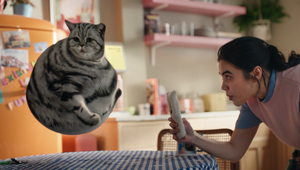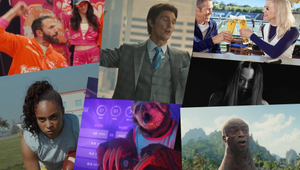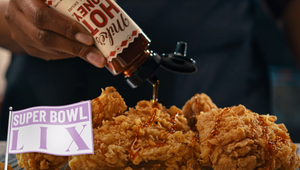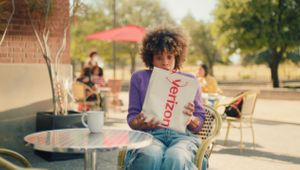
How Ford Put the ‘Scary’ into ‘Scary Fast’
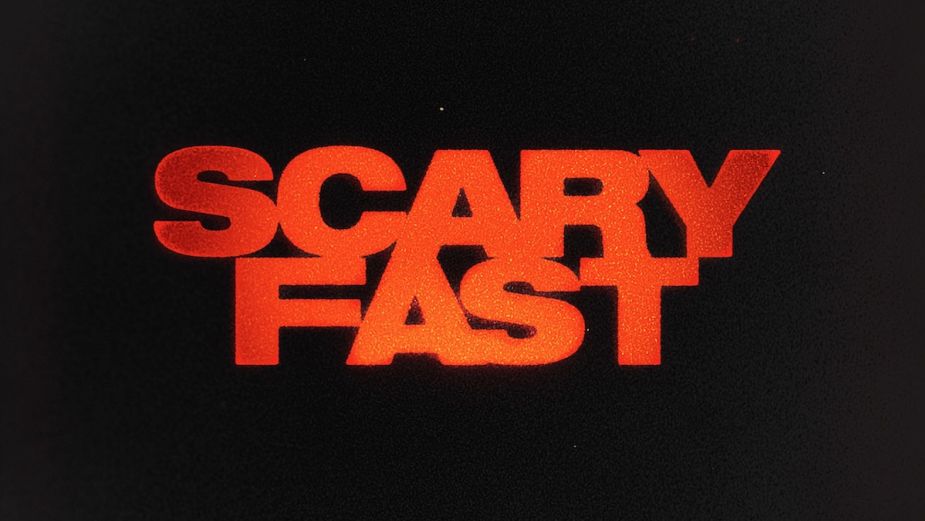
Using the stylings of classic horror movies, Ford launched the new F-150 Raptor R pickup truck with a terrifying trailer, directed by Lauren Sick. To create the bone-chilling atmosphere and noises that go bump in the night, sound companies HENRYBOY and Sonic Union, as well as VFX Studio The Mill New York embraced their horror inspirations, helping make one of the scariest and most unorthodox car ads in recent memory.
To get a sneak peek underneath the visual effects wizardry which gave the wolf its demonic eyes, produced a fiery eclipse and created a shadow monster straight from the silver screen, LBB’s Ben Conway spoke with Jimmy Bullard, creative director at the Mill New York.
And to hear an exciting earful about the spooky sounds that are sure to send a shiver down your spine, Ben also caught up with the mad scientists who brought life to the spot’s audio, HENRYBOY sound designer Bill Chesley, as well as Sonic Union’s mix engineers/sound designers Steve Rosen and Julienne Guffain.
Behind the Hair-Raising VFX
- with Jimmy Bullard, creative director at The Mill New York
As a horror fan, this script had immediate curb appeal. Lauren [Sick, the spot’s director] had a great treatment put together with some excellent references which we immediately began brainstorming ways to pull off. We put together a few decks exploring some different ways of treating the various horror ideas. We had a whole bunch of ideas for the moon eclipse and explored the most interesting ones during the post schedule.
Camera movement was a big driving factor, (sorry, can't resist) and we tried to keep the energy up using camera shake, contra zooms and lots of great camera action during the build ups - and then dialled it down to more slow moving cameras for the creepy moments, like the creature at the flaming cactus.
Tropes are an integral part of horror films for me. I've always enjoyed self-referential horror that can poke fun at itself while also giving you a good scare. We all know the jump scare is coming, but it still gives us a mild heart attack every time and that's what makes it so exciting. You can enjoy the buildup of terror because you know the release is coming soon.
There were around 25 or so heavy visual effect shots we took care of for the main film. The key sequences and specific effects we focused on were:
1. The Moon, its transition and the effect it has on our hero driver. We did a variety of style frames and motion tests for the look of the moon and the driver's eyes, ultimately settling on a fiery and evil-looking moon.

2. The wolf. Viewers may be surprised to realise just how much work we put into the wolf to get him to look scary. In reality, he was a loveable canine who wanted nothing more than to look friendly and cute. In the shot where he disappears back into the darkness, he originally had his mouth shut and looked very adorable. As such, we completely replaced his face with a snarling mouth and gave his eyes an otherworldly red glow. The only animal we worked on, in the end, was the wolf. The scorpion and rattlesnake were very well behaved and put in solid performances. There was also a jackrabbit that put in some great ad libs, but alas, wound up on the cutting room floor.

3. We worked on a look for the ‘ghost ship’ sequence with the glowing windows. The car was rigged with lights and the windows were frosted on the shoot; we worked up a nice look that enhanced this, adding some interesting lens flares for certain shots.

4. A significant number of shots were ‘day for night’ - meaning they were shot during the day, but in the grade were swung to look like night time. Dante (colourist) put together an amazing grade. The ‘day for night’ shots - with the blue tint - were very ‘Mad Max Fury Road’ and in order to help sell this effect we comped in headlights and taillights, including lens flares, glows and realistic interaction with the ground. The sequences having their own interesting colour palettes really helped lend some variety to the film, and kept each section feeling unique, but also tied together.

5. We designed a look for the creature that runs in front of the flaming cactus and completely replaced it in the shot of the dust left behind as the truck peels out. We did a lot of concept frames to work out what the design of the creature should be, and the final one we landed on is super creepy, with its extended limbs, long talon fingers and weird spikey head. Brilliant!

6. The cactus burning was enhanced by mixing a number of plates and elements together to create a larger, more intense cactus fire.

7. Of course the jump shot! This was a last-minute decision that had not even been discussed until a few days before delivery. This jump was filmed for real, with a super-safe car (rigged with a roll cage and all the safety gear) and a talented stunt driver. Once in post, we worked up style frames to determine the look of this shot and then built a complex scene filled with layers of atmosphere and a stylised matte painting for our backdrop, all while managing to keep the interactive dust elements from the original plate. It screams werewolf and has great throwback appeal.

The sheer amount of creative work in the time frame meant everyone had to be firing on all cylinders. Not just to get the work done and keep it up to the standards we are proud of maintaining, but also to make sure that we did adequate creative exploration. On a shorter schedule, it can be easy to go with the first great idea you have, but that isn't always the best idea there will be. We definitely improved some shots and sequences by putting in the extra effort to try some different avenues before committing to a concept or execution. The challenges were well worth the experience for the team and the amazing outcome.
From the moment we spoke with our friends over at W+K about this film, we were committed. It's not every day you have the opportunity to work on something as unique and exciting as this. We had people asking to be put on the job, knowing the turnaround was extremely tight, just so they could have the opportunity to do some cool horror shots. It was a great experience for everyone and the team is very proud of their work.
The sound mix is fantastic and really helps with all the story beats. I love the moment when the weird, otherworldly creature scuttles in front of the fire. It's really unexpected! The weird sound design helps make that shot feel really strange to me.
Behind the Spine-Chilling Sounds
-with Bill Chesley, sound designer at HENRYBOY and Sonic Union’s mix engineers/sound designers Steve Rosen and Julienne Guffain
LBB> Where did you get inspiration for the sound design? Do you have any horror film favourites that you revisited or that have influenced your work?
Bill> I thought the sound design in season four of ‘Stranger Things’ was amazing. It was fresh but had an ‘80s John Carpenter kinda feel. I tried to incorporate some of that sensibility into the Raptor spot - new and fresh, but also derivative. I found the Raptor spot itself quite inspirational. Wieden + Kennedy NY said ‘go for it’ - so I did. I don’t get to create that kind of mad abstraction very often. It was a real treat.
LBB> Did the project require any foley work? Or are the sounds largely digital? How much of the sound was recorded specifically for this spot versus from sound libraries etc?
Bill> I created every sound in the spot from scratch (with the exception of a couple of animal sounds from the library). There wasn’t a lot of foley, but one of my favourite moments was the scorpion towards the beginning. I made its movements using honey, sandy dirt, cashews and toothpicks. While synths played a role, I enjoyed finding sounds from field recordings and playing with them in the box. Most of the sounds in the spot were sourced from field recordings - squeaks, bangs, whooshes, etc. that I’ve recorded and archived in Soundminer over the past 30 years.
LBB> The metallic scraping noises to accompany the hand on the wing mirror and other intense moments are truly terrifying - how were these sounds achieved?
Bill> The hand on the mirror sound was sourced from an armoire door in Positano, Italy. It’s housed in a really nice villa (I can get you the address). I always carry a rig of some sort - a Sony PCM-D100, D10, or my Sound Devices 722 with an AT BP4025 if I’m up for carrying it. That squeak has been in my head since 2016 - I saw the hand and ‘BINGO!’ A perfect opportunity! I put it through a resonator, some delay, verb and Bob’s your uncle.
LBB> Which sound was the most fun to design and create? And which posed the biggest creative challenge after seeing the footage or brief?
Bill> There is a little ‘theme sound’ - an interval; maybe a fifth or a third - that I created using, again, a door squeak (I heart door squeaks). It starts the spot, and returns two or three times. It sounds kind of iconic to me. That was a fun moment. The biggest challenge was getting the engine noises to stay in the real world, but also reflect the power and threatening nature of the spot. I received wild sounds of the truck from W+K.
LBB> How did you design the sound to blend engine noises with the more theatrical horror film-style sound effects? Did you have recordings of the actual Raptor’s engine or do we hear a generic engine noise?
Bill> Car commercials are very difficult. If you are not tasked with recording the cars yourself, (which I have been, and it’s a blast), you are at the mercy of what you receive. This can be a frightening proposition because recording a car, especially one as dynamic as the Raptor, is not easy. The Raptor recordings were pretty good, but it took me hours to cut the wild sounds together so that they were cohesive on a narrative level, and as dynamic as they needed to be. There were five mics on the Raptor - one tail pipe, two interior, and three engine. I chopped and mixed between these five sources to create perspective shifts, and added some EQ and low-end enhancement plugins to give the car some kick.
After I got the car where I roughly wanted it, I doubled back and started adding the sound design elements - the fun part. It gets very editorial. Thanks to RPS for the nice cut. How the sound design enters and exits relative to the actual car sounds is where the rubber meets the road (ha). I think one of my strengths is creating flow - getting from A to B to C, and within that flow, creating shocks and surprise.
LBB> How early in production did you start working on the sound design? Were you designing even before you saw the rough cuts?
Bill> The post schedule was super tight because the VFX were being figured out right up to the mix. I got a very rough cut on a Monday and had kicked out a version by Wednesday. Most of it ended up in the final. This was to a fairly unrendered cut, so my sound designer brain had to take some leaps, as far as what would actually pan out visually. Fortunately, the crew at W+K NY are the best, and they gave me a great brief. It was tight as hell but really fun. I’m used to working in a pressure cooker, and honestly, kind of prefer it.
LBB> The spot uses silence really well. How did you design the spot to have these contrasts in dynamics and sound? Why does it work so well for horror?
Bill> One of my mantras has always been ‘if everything’s loud, then nothing’s loud’. The agency made it clear that they wanted the spot to have a real sense of quiet to help build tension. The volume arc of the various sequences is as important as the sounds themselves, so I paid particular attention to this dynamic.
This is why I mix as I sound design. With tight turnarounds such as this one, I don’t see any other way to work. It gives the agency a real sense of where we are, and where we will end up. So, as we hit mix day, everyone knew exactly what they were getting. Kudos, of course, to the good people at Sonic Union for hitting the mix with a fresh set of ears, and some great ideas.
Steve> Without quiet, there can be no loud. In order to evoke shock and surprise, the quiet moments are inordinately important. If you can pull a viewer in closer, forcing them to pay attention, you’ve then created the opportunity for something to scare the living daylights out of them.
Julienne Guffain> Silence is hot right now, I’m not afraid to admit that. It’s effective and evocative, and it makes a listener lean in. We definitely wanted that kind of dynamic in this spot. Actually, it isn't really a spot. There’s no offer or call to action. It's a trailer, and trailers are the king of dynamics. So we had to approach this mix as we would a big budget trailer.
LBB> From a general perspective, how different was working on this spot compared to other car ads? How well does the sound design of horror films crossover with automotive sound design?
Bill> This was a very unique opportunity for me to flex a bit in a genre that I don’t typically encounter in the ad world. One of the first things said in the initial brief was ‘we want this to be a horror movie trailer’. It was thrilling to hear, and they let me go for it, which was amazing! There was no time - the planets just aligned. The Raptor has a 700hp engine, which is pretty scary, so combined with the overall concept and the freedom I was given, the synchronicity between ‘car spot’ and ‘horror movie’ felt very organic.
Julienne Guffain> The challenge with genre-leaning in a car commercial is always going to be staying true to the real sound of the vehicle. That’s paramount to Ford. We are lucky to receive multi-mic recordings from the set of the car performing various moves. But in a piece like ‘Scary Fast’, we have to get creative in the mix to get the Raptor’s space to shine. It’s a delicate balance of carving out space and using digital tools to bring elements forward.
Steve> It’s not hard to make a 700-horsepower engine sound good. It’s true that as we move more and more towards electric, we’re losing a little opportunity for that old school sound, but at the same time, this opens up a window for car manufacturers to potentially create new, distinct sounds for all their vehicles, and we can play a part in that. In the meantime, that 700 horsepower engine lives in the same aural space as a lot of the horror sounds, in that it’s a growly beast.
LBB> Which is your favourite sound/element or moment in the spot and why?
Bill> My favourite moment is the four-shot sequence at the end of the burning cactus scene when the wolf appears at the side of the Raptor. It feels like a classic horror movie ‘jump’ moment.









